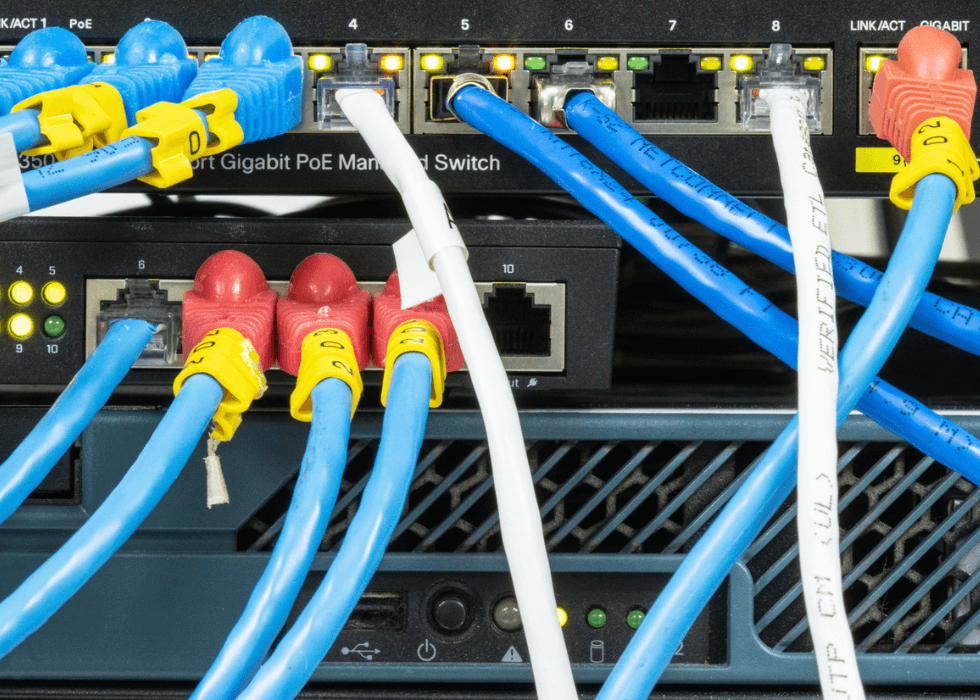
What Is a Power Over Ethernet Switch?
Power over Ethernet (PoE) switches are more than just a convenience in today’s evolving AV and IT environments. They are a necessity. As AV systems become increasingly dependent on efficient network designs, understanding the role and capabilities of PoE switches is crucial. It’s also essential for professionals pursuing AVIXA’s Audiovisual Network Professional (ANP) certification, which emphasizes both foundational and practical knowledge of networked AV systems.
A thorough understanding of PoE switches gives AV professionals a technical edge and enables more scalable, efficient system design, making it a key focus area for ANP certification candidates.
What is a Power over Ethernet Switch?
A Power over Ethernet (POE) switch is a network switch that transmits data and delivers electrical power to devices over the same Ethernet cable. It eliminates the need for separate power supplies and allows for cleaner, more efficient installations.
Devices such as wireless access points, IP cameras, VoIP phones, and AV-over-IP equipment benefit from PoE. PoE switches are particularly useful in commercial and enterprise AV networks, where central power and flexible installations are vital.
How PoE Switches Work
PoE switches function by delivering DC power over the twisted pairs of Ethernet cabling. This process is defined by standardized methods known as Mode A and Mode B:
- Mode A: Delivers power over the same wire pairs used for data transmission (pins1, 2, and 3, 6).
- Mode B: Sends power over the unused wire pairs in a typical 10/100 Mbps Ethernet cable (pins 4, 5, and 7, 8). For gigabit Ethernet and above, all wire pairs carry both data and power.
A PoE switch automatically detects whether a connected device is PoE-compatible and then provides power accordingly. This intelligent feature ensures devices receive the right amount of power without manual configuration.

Types of PoE Switches
There’s no one-size-fits-all PoE switch. Different network setups require different switch capabilities depending on the number of devices, control needs, and infrastructure demands. Some switches are made for basic connectivity in small offices or classrooms. In contrast, others are designed to power and manage dozens of devices in high-bandwidth environments like command centers or large-scale AV installations.
The key variables include power output per port, total power budget, number of ports, network speed (1G vs. 10G), and environmental durability (fanless, ruggedized, etc.). Selecting the right type hinges on assessing both current needs and future scalability.
Managed vs. Unmanaged
Managed PoE switches offer advanced features such as Virtual Local Area Network (VLAN) support, Quality of Service (QoS) and traffic prioritization, remote monitoring, and security policies. They are ideal for enterprise environments or AV-over-IP deployments that demand flexibility, scalability, and tight control. Administrators can segment traffic, monitor device health, troubleshoot remotely, and fine-tune performance.
Many support Simple Network Management Protocol (SNMP), Internet Group Management Protocol (IGMP) snooping, and Link Layer Discovery Protocol-Media Endpoint Discovery (LLDP-MED), allowing for deeper integration with networked AV and control systems. Firmware upgrades and port-level diagnostics are also available to maintain uptime and security.
Unmanaged PoE switches are plug-and-play. They don’t offer configuration options, but are useful in smaller setups where simplicity and cost-effectiveness are priorities. These are common in small businesses, classrooms, or single-room AV systems where all devices reside on the same subnet and don’t require advanced traffic management. While limited in features, unmanaged switches are reliable for powering devices like IP cameras, wireless access points, or basic digital signage, especially where network complexity is low and budget constraints are tight.
PoE Standards
Three main Institute of Electrical and Electronics Engineers (EEE) standards define how much power PoE switches can deliver:
- IEEE 802.3af (PoE): Delivers up to 15.4 watts per port. It is suitable for devices like VoIP phones and simple IP cameras.
- IEEE 802.3at (PoE+): Delivers up to 30 watts per port and is used for more power-intensive devices such as pan-tilt-zoom (PTZ) cameras and wireless access points.
- IEEE 802.3bt (PoE++): Offers up to 60 watts (Type 3) or 100 watts (Type 4) per port, supporting high-demand AV devices like digital signage displays, lighting control panels, and even small appliances.
Key Features of PoE Switches
PoE switches offer several features that make them essential for modern AV and IT infrastructures:
- Scalability: Easily expand your network by adding more devices without overhauling the power infrastructure.
- Cost-efficiency: Reduce the need for separate power installations, outlets, and electricians.
- Simplicity: Deploy devices using a single Ethernet cable for power and data, minimizing cable clutter and installation time.
Benefits in Network Infrastructure
Power over Ethernet switches streamline AV and IT systems by providing centralized power, greater flexibility, and enhanced operational reliability.
Centralized Power Management
PoE distributes power from a central switch rather than through individual wall adapters. This centralization simplifies maintenance, allows for backup power integration via UPS, and reduces the chances of device failure due to individual power supply issues.
Flexibility of Installation
Without the need to be near a wall outlet, devices can be installed in more strategic or unconventional locations—ceilings, rooftops, outdoor enclosures—wherever the network cable can reach.
Enhanced Reliability
Since PoE is standards-based and self-regulating, there's less risk of overloading devices or improperly powering sensitive AV hardware. Managed switches also make it easier to monitor and diagnose problems remotely, improving uptime and performance.
PoE Switches in AV Systems
In AV environments, where signal integrity, control, and uptime are paramount, PoE switches help simplify design and enhance system performance.
Integration in AV Networks
AV-over-IP technologies use Ethernet infrastructure to transmit audio, video, and control data. PoE switches streamline AV system design by powering encoders, decoders, cameras, touch panels, and digital signage displays without extra cabling or power adapters.
They also allow for remote device resets and firmware updates, which can be essential in environments where physical access to devices is limited, such as in ceiling mounts or secure enclosures.
Importance for ANP Certification
Understanding how PoE works—and how to implement it in AV networks—is a crucial component of the AVIXA ANP certification. Certified professionals are expected to demonstrate practical network infrastructure knowledge, including selecting, configuring, and troubleshooting PoE switches as part of larger AV-over-IP ecosystems.
Mastering PoE switch technology gives ANP-certified individuals a professional edge, allowing them to design more intelligent and more efficient systems that meet the demands of today’s connected AV spaces.
Want to deepen your expertise in AV networks and stand out in the field? Learn more about AVIXA’s Audiovisual Network Professional (ANP) Certification and gain the knowledge that makes you indispensable in modern AV environments.
Choosing the Right PoE Switch
Choosing the correct PoE switch is a foundational step in building a reliable AV or IT network. The wrong switch can lead to underpowered devices, wasted budget, or system failures.
Consideration Factors
When evaluating which PoE switch to purchase or specify, consider the following:
- Power budget: Calculate how many watts each connected device will draw and ensure the switch can supply enough total power.
- Port count: Choose a switch with enough ports for current and future expansion. It’s often better to plan for extra capacity upfront.
- Environmental requirements: Industrial environments may need hardened switches that tolerate temperature extremes or offer rugged enclosures.
- Future-proofing: Look for switches that support newer PoE standards or cloud-based management to extend system longevity
Also, consider whether a managed switch is necessary for VLAN configuration, QoS for video prioritization, or remote management.
Common Challenges and Solutions
Despite their advantages, PoE switches can present a few challenges. Awareness and preparation can help professionals avoid costly errors.
Overcoming Power Limitations
One common issue is exceeding the switch’s power budget, which can cause devices to malfunction or not power on at all. The solution is to calculate the combined wattage of all connected devices and choose a switch with an adequate power budget. For high-power devices, opt for PoE+ or PoE++ switches.
Compatibility Issues
Another challenge is device compatibility. Not all endpoints are PoE-compatible, and not all PoE switches support higher standards like 802.3bt. Always verify the power requirements and standards supported by your devices and match them with the appropriate switch.
Power Over Ethernet Switches: The Takeaway
Power over Ethernet switches have become indispensable in AV and IT network design. Their ability to simplify installations, reduce infrastructure costs, and enable centralized control makes them vital to any professional AV system, especially those involving Audiovisual over Internet Protocol (AV-over-IP) technologies.
Understanding PoE switches is required for AV professionals pursuing the AVIXA ANP certification. ANP certification validates your ability to design and manage networked AV environments effectively, and PoE expertise is a key part of that skill set.
Whether you're deploying cameras, digital signage, touchscreens, or control systems, PoE switches provide the flexibility, reliability, and efficiency required to meet today’s complex AV challenges.








